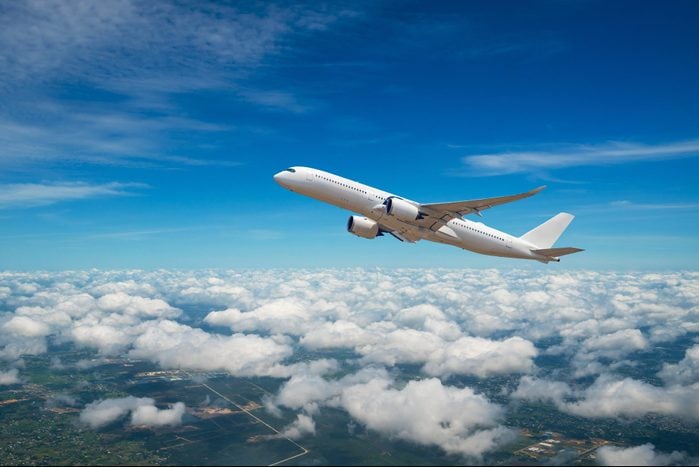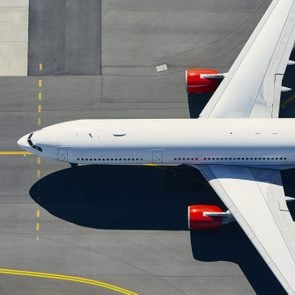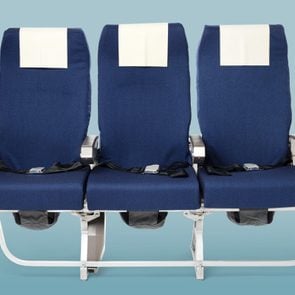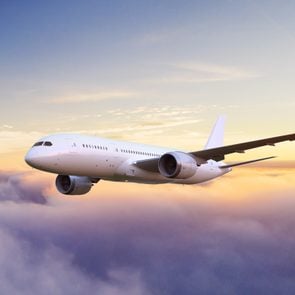How High Do Airplanes Fly, and Why?
Updated: Jan. 31, 2023

If you've ever wondered how high airplanes fly and why they need to maintain cruising altitude, you're in the right place!
If you’re a frequent flier, you may barely pay attention to the routine stages of flight. The airplane takes off, then climbs for the first 15 to 20 minutes of the flight. Once the plane reaches cruising altitude, flight attendants start making their rounds, and the pilot may announce that you’re free to move around the cabin (though you still have to leave your phone on airplane mode). Once the descent begins, it’s time to fasten those seat belts in anticipation of landing. In that time between ascent and descent, the airplane is cruising at a steady altitude. But how high do planes fly? And why do they have to stay at a set altitude? If you’ve ever asked these questions during those long hours spent staring out that little round window, we’ve got the answers to this burning bit of airplane trivia!
How high do planes fly?
The cruising altitude of a commercial aircraft depends on the size of the plane. But generally, most commercial passenger jets cruise at between 32,000 and 40,000 feet—or six to seven-and-a-half miles off the ground. Turboprop planes, which are smaller aircraft that typically carry a handful of passengers, rather than hundreds, fly at a lower altitude of about 25,000 to 30,000 feet. But since these propeller planes are often used for short-haul flights, they may stick to lower altitudes simply because by the time they reach a higher altitude, it’s time to begin their descent. Have you ever wondered how many planes are in the sky right now?
What happens if an airplane flies too high?
Remember the story of Icarus, the character from Greek mythology who flew too close to the sun and perished when his wings melted? Passenger planes aren’t at risk of melting if they fly too high, but there are cabin-pressure and oxygen concerns that dictate that they remain below set altitudes. Theodore Kyrazis, an Airbus A-320/321 captain and a retired USAF F-15 pilot, explains it in non-aeronautic speak:
- Emergency oxygen supply: Airlines impose altitude limits, Kyrazis says, “to ensure there is enough oxygen supplied to all the masks for the amount of time it takes to accomplish an emergency descent to an altitude where the oxygen masks are no longer required (around 10,000 feet).”
- Sudden cabin depressurization: A loss of cabin pressure can occur if a plane flies too high, and if that happens, passengers and crew—including pilots—can lose consciousness. When it happens with a fighter jet, Kyrazis explains, “it’s a simple matter of rolling over and going straight down back to a comfortable altitude in less than a minute. It’s not so trivial for a commercial aircraft.”
- Equipment failure: “Almost all modern aircraft have sophisticated computers monitoring aircraft weight, speed, outside air temperature, wind speed and direction, and the angle of the wing relative to the incoming wind,” Kyrazis says. “If a pilot were to try climbing above the recommended altitude and keep going, either the engines would not produce enough thrust to keep climbing or the wings would stall.”
The bottom line? You want your pilot to stick to the recommended altitude!
Other reasons planes fly at cruising altitude
Fuel economy
Commercial airlines need to operate as efficiently as possible in order to make money—and not just by charging for in-flight Wi-Fi. This makes fuel economy one of the most important factors in how high planes fly. The short answer, according to Kyrazis, is that turbojet engines burn less fuel as the air density gets lower. There are some fancy calculations involved, but essentially, the speed and angle of degrees at which the plane climbs are determined both by weather conditions and the size of the plane; bigger aircraft weigh more, in part, because they’re carrying so much heavy fuel, which burns off as they climb.
According to Kyrazis, one hour of climbing may burn off a whopping 10,000 pounds of fuel. And get this: “If a major airline saved just one gallon of gas on every one of its flights for a full year, the cost savings on that one item would be over $15 million!”
Speed
The higher a plane flies, the faster it can fly—to a point. “Less-dense air at higher altitudes means the actual speed the aircraft is traveling over the ground is much faster than the aircraft speed indicator shows the pilots in the cockpit,” says Kyrazis. That means the plane is making better time than even the instruments show. But the flip side is that extremely cold temperatures will slow the plane down. To balance that out, pilots find that happy medium between fuel-saving high altitude and the slowing effects of subzero temperatures. In case you’re wondering, this is not why it’s so cold on airplanes.
Turbulence
No one likes to encounter turbulence on a flight, but it’s most likely to occur during ascent and descent. “Much turbulence associated with weather systems can be avoided above 35,000 feet,” says Kyrazis, which is part of the reason commercial airliners like to climb above storms and stay there. The exception, he says, are thunderstorms, which can reach 50,000 feet into the atmosphere. When that happens, the airplane has to either go through the storm or around it.
What happens if a plane flies too low?
Despite all the frightening things that can happen if a plane flies too high, flying too low can be just as dangerous. Apart from flying through lower-lying bad-weather systems, there’s a lot more general aviation traffic at lower altitudes, including that of smaller commercial and private aircraft.
Another big risk of flying at low altitudes? Running afoul of birds. “Most bird strikes occur during takeoff and landing,” says Kyrazis. That includes the 2009 “Miracle on the Hudson” and the heroic landing by Captain “Sully” Sullenberger. Flying above 10,000 feet greatly reduces the risk of an encounter between bird and plane.
Next, find out what happens when you flush an airplane toilet.



